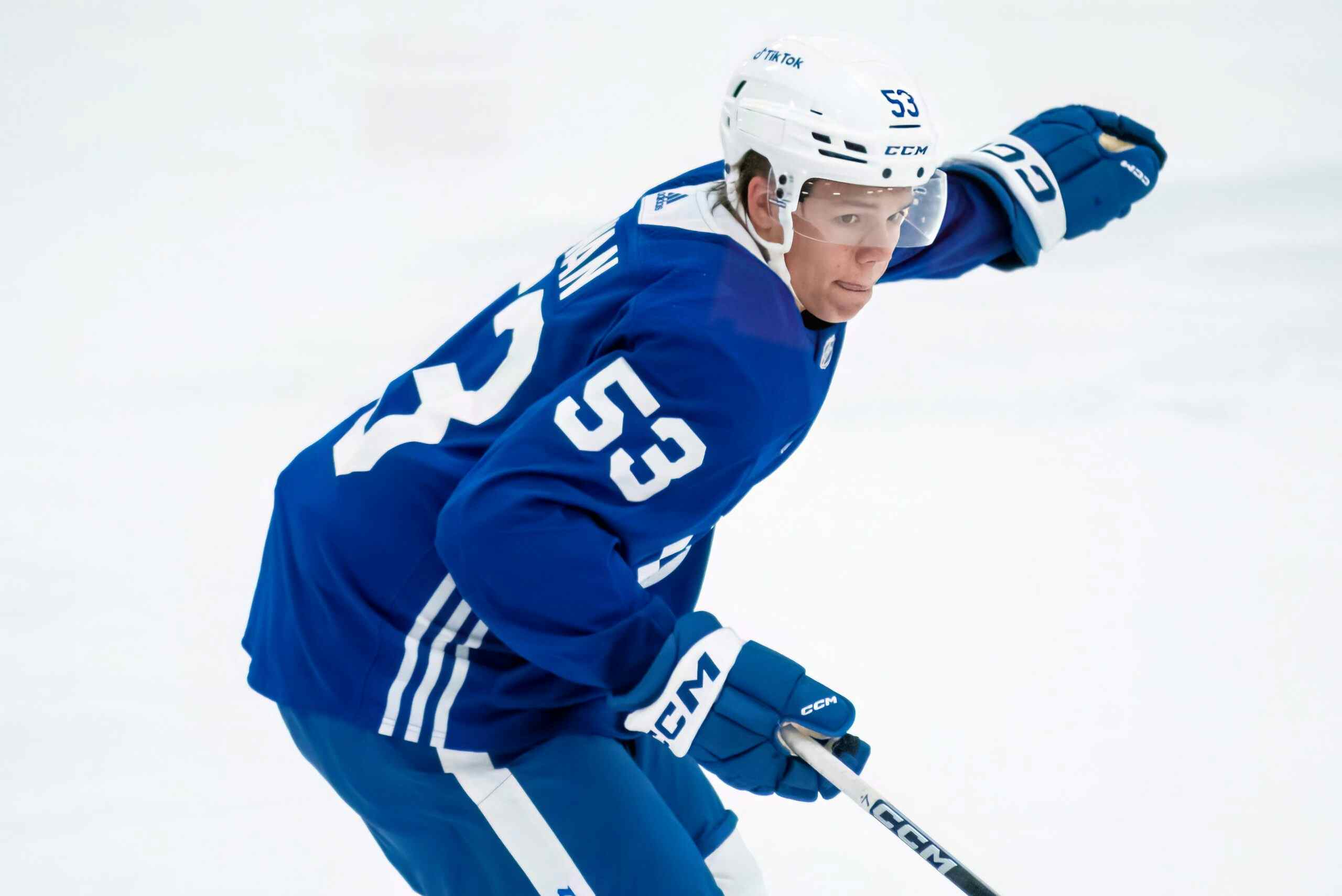Toronto’s first half analytical update
By Cam Charron
10 years ago
Well we’ve hit the midway point of the season. Technically, we’ve already finished Game 42, but there was a small turnaround between Games 41 and 42, and a nice clean day on the calendar for us this morning to fit in this little post breaking down the first half of the season for the Toronto Maple Leafs.
Overall, the Leafs are doing pretty well. They’re (slightly) out-performing my expectations, on pace for 92 points over 82 games. The big issue with their record is the low number of regulation and overtime wins, which is the first tiebreaker at the end of the season. Despite being 5th in the East in points, the Leafs are 12th in ROW, which is something to keep an eye on if the standings tighten up.
But really, they aren’t. The Leafs began ‘Deathcember’ with four points of separation on the final Wild Card spot, played like crap, and then recharged and won three straight. They’re now… four points up on the final Wild Card spot, with the Detroit Red Wings as a buffer. I didn’t think I’d say it this late in the season, but Toronto are sitting in good position. And that has me worried.
Data below is found via BehindTheNet, HockeyAnalysis and ExtraSkater. All three are really indispensable resources if you are a hockey fan. Visit them, learn to navigate them, and a light will go off and you’ll start to see hockey played a little differently in your mind. Below are some first half observations using a little of the above.
THE FORWARDS
For those of you unfamiliar with Player Usage Charts, a more in-depth explanation can be found here. Basically, the circles indicate a player’s possession numbers: blue represents positive Relative Corsi (the team is more likely to out-shoot the opposition with that player on the ice) and red is negative, with the size of the circle corresponding to how high of a plus or minus the player is. Where the bubbles are placed is dependent on the usage. Hard minutes against tough competition are placed higher on the chart (vertical axis) and more shifts starting in the offensive zone are towards the right. The players, ergo, in Quadrant II (who remembers Grade 10 math?), or the upper left part, are playing the toughest minutes. The lower and further to the right, the easier.
Here’s the Player Usage Chart for the Leafs, via somekindofninja, with data from Behind The Net:

The names that stick out here are David Clarkson, Peter Holland, and Colt Knorr, who seem to have circles coloured differently than you might expect from their minutes played. Knorr just completely whacks the proportions with how easy his minutes are, and manages to be outstandingly out-shot when he’s on the ice. Holland gets a lot of offensive zone starts, but fails to push the play north. He has a lot of skills inside the offensive blue line but is otherwise limited. Clarkson is a weird case, and we’ll get to him below.
The major problem you get is that no forward is on the Leafs for more shots for than against. The best is Nazem Kadri. When he’s on the ice, his Corsi is -7.72 per 60 minutes, meaning every 60 minutes of ice-time, the opposition is going to outshoot him by nearly 8 shot attempts. We keep saying that that’s not a recipe for sustainable success, and it’s become noticeable lately. The offence has dried up because the team takes so few shots, that they need the goalie to steal them a win every game to have a chance, except on rare occasions.
SO WHAT’S THE DEAL WITH DAVID CLARKSON
I don’t know. I really don’t know his deal, but he really seems like a player that will be on the ice for a lot of shots for, but not of exceptional quality. Usually, whenever a player seems like somebody that isn’t taking particularly good shots, he’ll turn it around just as you’re about to write him off (Mason Raymond). Here’s Clarkson’s on-ice shooting percentages since 2007-2008:
| Team Sh% | |
|---|---|
| 2008 | 10.16% |
| 2009 | 6.99% |
| 2010 | 9.77% |
| 2011 | 4.18% |
| 2012 | 7.64% |
| 2013 | 5.49% |
| 2014* | 5.58% |
Basically, it’s a slow dip. I’ve learned never to be fooled into thinking there’s meaning for everything, and there’s a chance that Clarkson’s low on-ice shot percentages are due to his miserable shooting ability, but it could also be luck. Clarkson’s hit what? Six crossbars from within three feet of the net so far during his tenure in Toronto? He was a player with 15-20 goal ability last year and appears to have lost half of that this season while maintaining virtually every other talent he has.
There’s probably a larger post on how players with high Corsi rates, but low shooting percentages, fare over the next year or so. Daniel Winnik is a success story. Martin Hanzal is a success story. A lot of players find their way out of the league before they have a chance to turn it around. Clarkson can’t because of his contract, so he’ll be a fun test case. The Leafs are sort of stuck with him, warts and all, so for now, we’ll be content in the fact that when he’s taking those painfully low-percentage shots on goal, it just means a player on the other team doesn’t have the puck.
NAZEM KADRI
We got into Kadri the other day. It feels like a matter of time before a swath of stories come out complaining that Kadri isn’t scoring regularly, or at all, and failed to take a hold of the team’s No. 1 centre spot when Tyler Bozak was out to injury.
I don’t see it like that. The Leafs got slightly better on the shot clock in December, getting outshot by two shots a game less than they were in October or November. It doesn’t seem like much, but every shot on goal counts when you’re as starved for shots and scoring as the Leafs. You look at puck possession numbers, and every player has been better this year with Kadri than without him:

Now, granted, Kadri doesn’t play checking minutes, and some of those forwards play on checking units when they don’t get to play with Kadri, but he’s been getting his chances. Getting chances, not necessarily finishing on them, is the sustainable talent in hockey, and Naz has been one of the lone bright spots on the Leafs as far as consistently affecting the shot clock in a positive manner goes.
Maybe the scoring picks up. Maybe not. If the Leafs are running into problems, Kadri certainly won’t be the main reason.
NIKOLAI KULEMIN
Ironically, in the offseason (and before the start of the offseason) I compared Kulemin to David Clarkson, calling him slightly younger, just as big, and presumably as likely to break out offensively. I think it’s the worst case scenario within which I’ve ever been right: despite regular minutes and a near-career-high 15.2% shooting percentage, Kulemin has just 5 goals on the year. His 1.1 shots per game is a full shot a game below where he was during his 30-goal season.
This is a bit of a sore point, and I swore I’d bring up these two as little as possible, but I’m beginning to think that Kulemin’s success was mostly driven by Mikhail Grabovski and Clarke MacArthur, both of whom are good two-way and offensive players on their new teams. The Leafs kept the one that fits on a “checking” line, but what is the checking line even doing this season? They get out-shot more than any line in the game. Leaf goalies stop .936 of pucks when Kulemin is on the ice at even strength, and .953 when Jay McClement is out there, and what’s going to happen when that goaltending dries up? I’ve taken a recent stand against checking lines because I’ve noticed they just get out-shot more than the offensive lines. The teams that have their checkers play a two-way game also put pucks on net and try and skate with the top lines, while the Leafs dump-and-chase and take what the opponent gives them.
THE DEFENCE

As expected, big red circles for Dion Phaneuf and Carl Gunnarsson, but they’re playing by far the toughest minutes. I get that Phaneuf is a +15 and Gunnarsson is a +9, so damn the Corsis, they’re getting results! But the fact is that plus/minus isn’t as indicative of long-term trends as Corsi. Keep in mind what happened to Mark Fraser a year ago compared to this year. His PDO (on-ice shooting plus save percentage) took a giant hit.
Per Behind the Net, Phaneuf and Gunnarsson have the two highest PDOs on the team. We’ll see what those look like after the next 40 games.
CARL GUNNARSSON
We’ve gone through Dion Phaneuf a bunch recently, but what about partner Carl Gunnarsson? I felt that Gunnar’s contract was a bit of a risk this summer because he was ailing last year, and he doesn’t look 100%. His point production has been more than halved, he’s taking more penalties than usual (about 0.6 penalties per 60 minutes compared to 0.3 in 2012 and 0.4 in 2011. He had 0.7 last year).
A simply WOWY shows that the top pairing are a 38.6% Corsi when on the ice together. I brought this up somewhat in my big Phaneuf post, that anything below 40% isn’t passable under any circumstances. I figure a good top pair should be close to 45%, and a great one should be close to breaking even, but 36-3 are getting way more out-shot than usual:
| 36-3 Corsi For % | |
|---|---|
| 2012 | 49.2 |
| 2013 | 40.4 |
| 2014 | 38.6 |
I think that the coaching staff is beginning to pick up on it too. Gunnarsson plays just the fifth most 5-on-5 minutes per game on the Leafs’ defence, behind Jake Gardiner, Phaneuf, Paul Ranger and Cody Franson. Perhaps this is a situation where the Leafs brass will put Tim Gleason’s experience against top competition to task and have him fill Gunnarsson’s role?
CODY FRANSON
The only other Leafs defenceman I have a point about which to make is Cody Franson, who is a positive Relative Corsi and appears to have the third-highest minutes based on the usage chart. That said, there isn’t a pairing partner with which he’s playing at a high level. I had high hopes for him and Jake Gardiner this year, but per Hockey Analysis, the two are a 44.6% Corsi together, and you hope for something higher than 45%, at least.
Still, Gardiner appears to be Franson’s best option, and Franson’s Corsi did turn around in December like most of the other Leafs’. Now’s a matter of sustaining the improvements through the new year.
THREE BIG QUESTIONS FOR GAMES 43-82:
No. 1 – Can the Maple Leafs stay out of the box?
Here’s the chart showing a big difference for the Leafs from November to December:
| PP/GP | TS/GP | Differential | |
|---|---|---|---|
| October | 3.36 | 3.79 | -0.43 |
| November | 2.69 | 3.85 | -1.15 |
| December | 3.43 | 2.79 | 0.64 |
The tide really turned around the Los Angeles game. The Leafs were having struggles on the penalty kill, but the best penalty kill is no penalty kill, and they cut their penalties taken by 38%, increase their powerplays drawn by 21%, and have gotten much better special teams results, going from a minus-8 goal differential in November on special teams to even in December.
Toronto still have a deadly powerplay but a brutal penalty kill, and they’re getting the right unit out on the ice more often than not. Tim Gleason has had some problems with penalties over the last couple of seasons.
No. 2 – How long can the goaltending hold up?
I’ve gone this whole time without mentioning Jonathan Bernier or James Reimer. Not anymore. Here’s a chart on goaltending progression throughout the season:

You can see that in both 5-on-5 and overall situations, the goalies have been well-above average. They’re currently combined for a .936, which is where the 2011 and 2009 Boston Bruins were for a full 82-game season. Basically, what Reimer and Bernier are doing right now is historical, but such a high percentage is probably difficult to sustain. It would be both unlikely and awesome if the number remained that high, but don’t hold your breath.
No. 3 – Where did the promised PDO regression go?
“Teams over a 1.030 PDO in the last three seasons have had an observed drop in points per 48 games of seven. That would put Toronto on a 52-point pace for the remainder of this season with all the wins they have banked. Would that be enough to make the playoffs? Not unless the team improves.”
Well… just missed. The Leafs’ PDO since then has been 1.024, just slightly below that 1.030 mark, and the team’s 82-game points pace has dipped from 96 to just 94. So perhaps a miscalculation on my part, but I still maintain that the Leafs are very lucky to be where they are in the standings. It’s fun to watch the reaction to the team’s wild, streaky swings, which invite a million “I told you so” rants from people of other camps. The Leafs season is fascinating to watch.
The Leafs are currently doing a good job of keeping the world convinced you can win in the regular season with low Corsi and high PDO totals, and sustain them. I’m not convinced that this style would work in the playoffs, and the Leafs seem to get beaten around pretty easily by good teams in this league. We’ll see what happens. There’s still a long way to go.
Recent articles from Cam Charron





